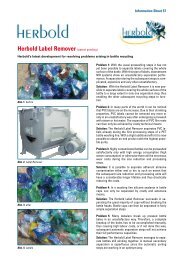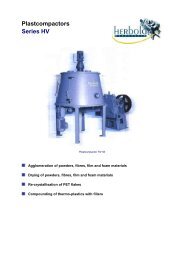Herbold Washing Lines Modular Washing Lines for Post-Consumer ...
Herbold Washing Lines Modular Washing Lines for Post-Consumer ...
Herbold Washing Lines Modular Washing Lines for Post-Consumer ...
You also want an ePaper? Increase the reach of your titles
YUMPU automatically turns print PDFs into web optimized ePapers that Google loves.
Hot washing step Treatment of flakes<br />
D1 Material storage basin / preheating<br />
The flakes are heated to the temperature of the<br />
hot washing step.<br />
D2 Intensiv washing and dispersion<br />
The flakes are thoroughly washed in hot water,<br />
caustic soda and detergents; glues are dissolved.<br />
D3 Separation of heavy materials<br />
Materials heavier than polyester (glass, stones,<br />
metals) are separated in the bulk material<br />
cyclone.<br />
D4 Separation according to density<br />
In a hydrocyclone remaining polyolefines and<br />
floating glues are separated from the polyester.<br />
D5 Separation of the suds<br />
The hot wash water with the detergents in it is<br />
separated from the flakes.<br />
D6Treatmentofthesuds<br />
The hot wash water is enriched with lye and<br />
detergents.<br />
D7 Clean rinsing<br />
The clean flakes are rinsed in water in order to<br />
obtain a neutral pH value.<br />
D8 Mechanical drying<br />
The flakes are dried to the required residual<br />
moisture.<br />
E1 Air separation<br />
Remaining film and polyester dust are<br />
separated from the flakes.<br />
E2 Metal separation<br />
Remaining metals are separated.<br />
E3 Color and material separation<br />
An electro-optical particle separation unit<br />
separates remaining <strong>for</strong>eign plastic bodies<br />
(mostly PVC) and undesired color flakes.<br />
E4 Increase of the bulk density<br />
A secondary granulator improves the bulk<br />
density and the flowability of the flakes.<br />
E5 Bulk density and crystallization<br />
A plastcompactor improves the flowability, bulk<br />
density and recrystallizes the flakes.<br />
Water Treatment<br />
F1 Water collection, screening<br />
The dirty water is collected in a pit and any<br />
contamination larger than appr. 0.1 mm is<br />
removed.<br />
F2 Sedimentation<br />
The screened water is stored in a<br />
sedimentation basin <strong>for</strong> the sedimentation of<br />
light contamination; the result is circulation<br />
water.<br />
F3 Storage<br />
The mechanically treated circulation water is<br />
stored.<br />
F4 Treatment of fines<br />
In a chemical or physical water treatment plant.<br />
F5 Reconveying into the plant<br />
A pump conveys the circulation water back into<br />
the plant.<br />
F6 Neutralisation (waste water)<br />
Decrease of the pH value according to the<br />
regultions <strong>for</strong> public water treatment.




